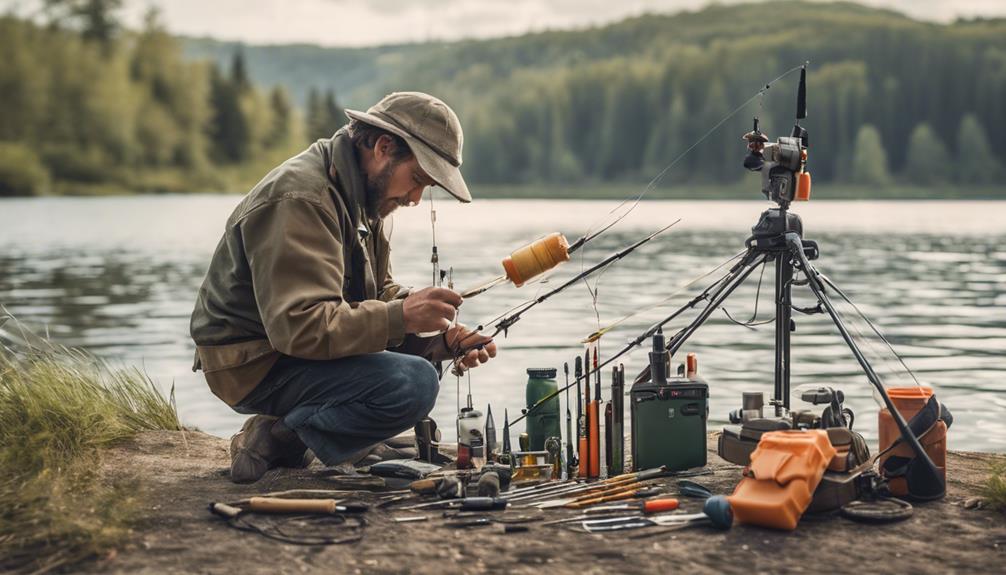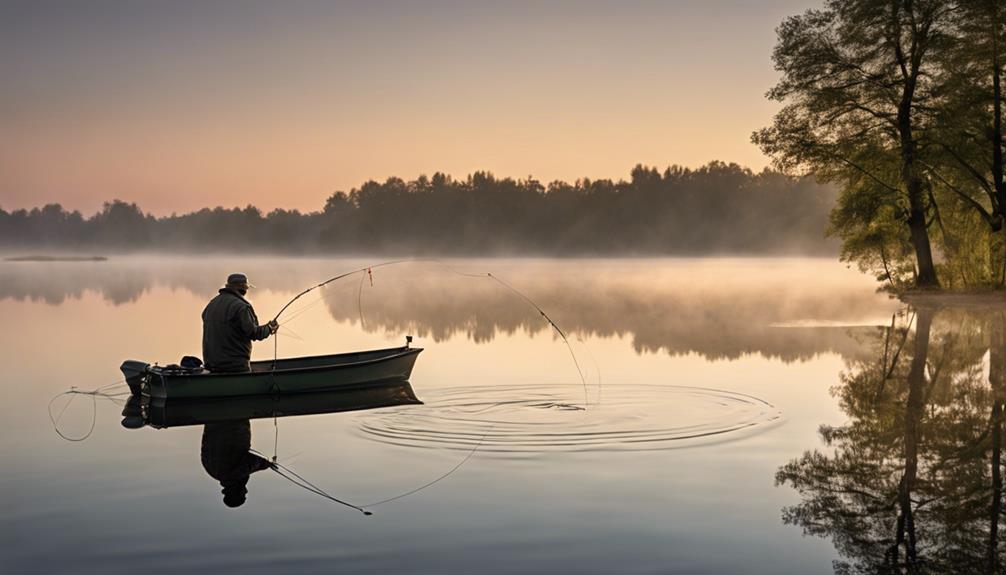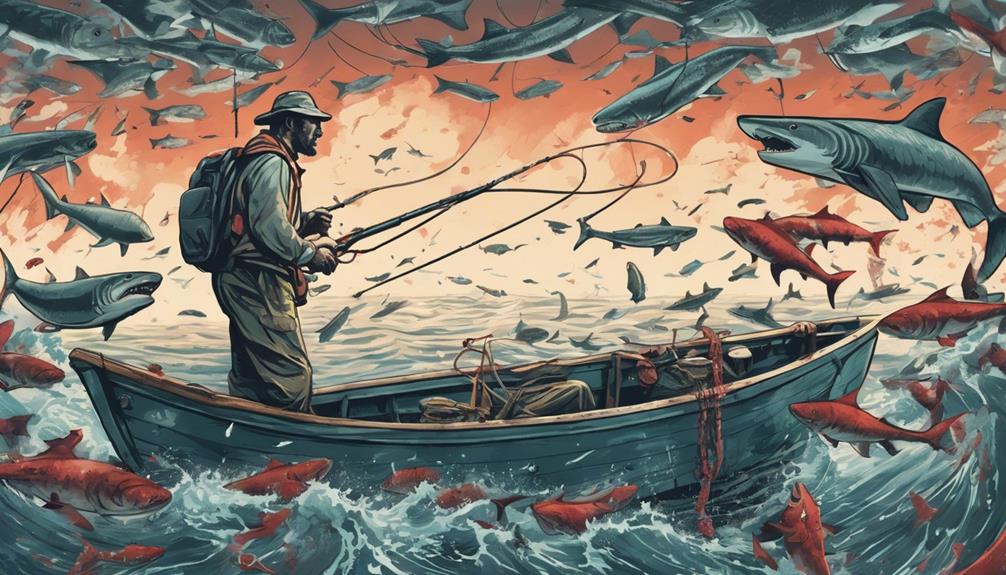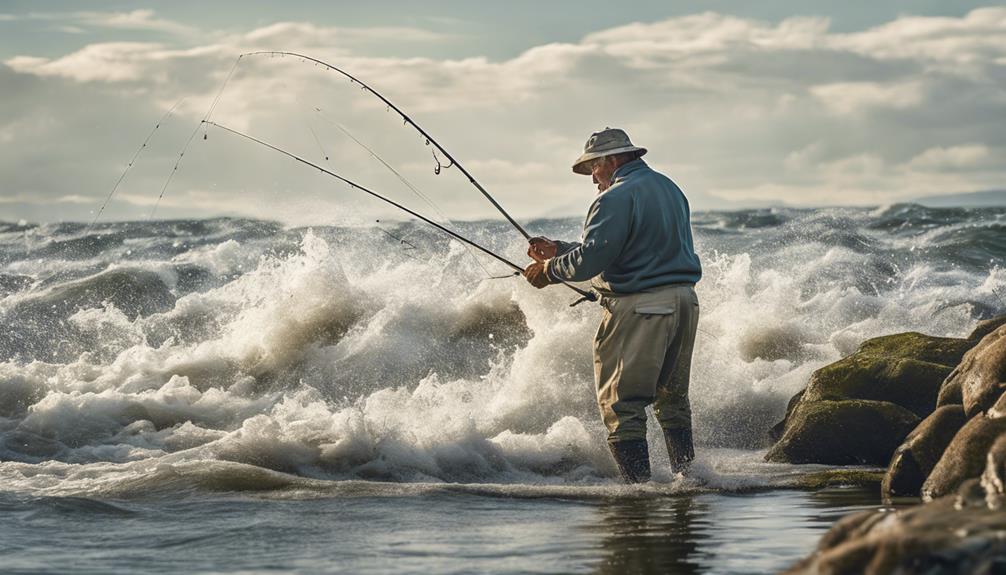So, you think you've mastered the basics of carp fishing? Think again. These eight advanced techniques will take your angling skills to a whole new level.
From innovative baiting strategies to analyzing intricate weather patterns, there's a world of knowledge waiting for you beneath the surface.
Unlock the secrets of successful carp fishing and watch your catch rate soar.
Baiting Strategies
To maximize your chances of catching carp, vary your baiting strategies to keep the fish interested and engaged. Carp are known for their keen sense of smell, so utilizing bait with strong scent dispersal is crucial. Boilies, pellets, and particles like corn or hemp are popular choices due to their ability to release enticing aromas underwater, attracting carp from a distance. By incorporating a mix of these baits, you can create a diverse scent profile that appeals to a wider range of carp.
Understanding carp feeding habits is essential for successful baiting. Carp are opportunistic feeders, often grazing on natural food sources like insects, larvae, and vegetation. Mimicking these natural food items can increase your chances of enticing carp to take your bait. Try adjusting your bait sizes and colors to match the prevalent food sources in the water you're fishing. For instance, using smaller baits during times when insects are abundant can yield better results.
Incorporating a method mix into your baiting strategy can also enhance your chances of success. Method mixes are groundbait concoctions that disperse scent and attract carp to your fishing spot. By molding your hook bait within the method mix, you can create a concentrated area of attraction, enticing carp to feed more aggressively. Experiment with different mixes to see what works best with the carp in your area, adjusting the ingredients based on their preferences. By adapting your baiting strategies to cater to carp feeding behaviors, you can significantly improve your catch rate.
Rigging Innovations
Keep your carp fishing game strong by exploring the latest rigging innovations that can give you an edge in attracting and hooking these elusive fish. When it comes to tackle customization and line selection, consider using adjustable zig rigs that allow you to vary the depth your bait sits at, increasing your chances of enticing carp at different levels of the water column. This technique is particularly effective when carp are feeding mid-water.
For bait presentation and understanding fish behavior, the multi-rig setup is gaining popularity among carp anglers. This setup allows you to quickly change hook baits without retying the rig, saving you valuable time on the water. Additionally, using a mixture of buoyant and sinking baits can create a critically balanced presentation that carp find hard to resist.
Experimenting with different hook patterns and sizes can also make a significant difference in your catch rate. For example, wide gape hooks are great for bottom baits, while curved shank hooks can improve your success with pop-up presentations. By understanding how carp feed and adjusting your rig accordingly, you can maximize your chances of landing that prized catch. Stay innovative and adaptable to stay ahead in the ever-evolving world of carp fishing.
Location Scouting
Explore different bodies of water to pinpoint the prime locations where carp are likely to congregate for successful fishing expeditions. When scouting for the best carp fishing spots, understanding the underwater topography and vegetation mapping can significantly increase your chances of a successful catch.
- Underwater Topography: Carp tend to gather near underwater structures such as drop-offs, submerged islands, or gravel bars. Understanding these features can help you locate hotspots where carp are more likely to be present.
- Vegetation Mapping: Carp are often found near aquatic vegetation like lilies, reeds, or submerged weed beds. Mapping out areas with abundant vegetation can guide you to where carp feed and seek shelter.
Precision Casting
When honing your carp fishing skills, mastering precision casting is crucial for accurately placing your bait in strategic locations where carp are likely to be present. To improve your casting accuracy, start by selecting the right tackle. A quality rod with the appropriate action for your fishing style, paired with a reliable reel and the correct line weight, will enhance your ability to cast with precision.
When setting up your tackle for precision casting, consider the weight of your bait and the distance you need to cover. Adjust the rod's casting weight and practice different casting techniques to find what works best for you. Remember, the key to accurate casting lies in the smoothness of your motion and the timing of your release.
Furthermore, understanding the wind conditions and how they affect your casting accuracy is crucial. Practice casting in various wind strengths and directions to become adept at compensating for these factors. Additionally, mastering the use of baitcasting reels can greatly improve your precision casting skills due to their fine-tuning capabilities.
Advanced Hook Setups
To enhance your carp fishing success, optimizing your hook setups with advanced techniques is crucial for increasing your chances of landing more carp efficiently. When it comes to advanced hook setups, paying attention to details like line strength and hook size can make a significant difference in your fishing experience.
Here are five key points to consider for advanced hook setups:
- Choose the Right Line Strength: Selecting the appropriate line strength is crucial. Carp have a strong pulling power, so using a line that can withstand their weight and energy is essential for a successful catch.
- Optimal Hook Size: Matching the hook size to the bait you're using and the size of the carp in the water is important. Using the right hook size increases the likelihood of a secure hookset.
- Consider Hook Patterns: Different hook patterns work better in certain situations. Experiment with variations to see which one works best for the type of bait and fishing conditions you're facing.
- Use Barbless Hooks: Barbless hooks can make unhooking carp easier and safer for both you and the fish. They also reduce damage to the fish, allowing for a more sustainable fishing experience.
- Adjust Hook Placement: Positioning your hook strategically can improve your hooking success. Consider the carp's feeding behavior and adjust your hook placement accordingly.
Stealth and Camouflage Techniques
Enhancing your carp fishing success involves mastering stealth and camouflage techniques to outsmart these wary and elusive fish. When it comes to stealth, it's crucial to move quietly along the water's edge and avoid making sudden movements that could startle the carp. Keep noise to a minimum, as these fish are sensitive to vibrations in the water. Additionally, wearing muted colors that blend in with the surroundings can help you remain unnoticed.
Investing in camouflage gear can significantly improve your chances of a successful catch. Consider clothing that matches the vegetation around the fishing spot, such as greens and browns. Camouflage hats and face paint can further help you blend into the environment. Remember, the goal is to become invisible to the carp's sharp senses.
A stealthy approach also involves being mindful of your shadow. Position yourself in a way that your shadow doesn't fall over the water, potentially alerting the carp to your presence. Furthermore, avoid unnecessary movements that could create ripples or disturbances in the water, signaling danger to the fish.
Weather Pattern Analysis

How can analyzing weather patterns contribute to your success in carp fishing? Understanding meteorological predictions and atmospheric conditions can greatly enhance your chances of a successful carp fishing expedition. By paying attention to weather patterns, you can adapt your fishing strategy accordingly and increase your likelihood of a good catch.
- Temperature Fluctuations: Recognize how temperature changes affect carp behavior. Warmer temperatures may make carp more active and likely to feed, while colder temperatures might slow down their activity.
- Wind Direction: Consider how wind direction impacts the movement of carp and the distribution of food sources. Carp tend to follow the direction of the wind, so positioning yourself accordingly can improve your chances of attracting them.
- Barometric Pressure: Be mindful of changes in barometric pressure, as these can influence carp feeding habits. A falling barometer might indicate an upcoming storm, triggering increased feeding activity.
- Precipitation: Understand how rainfall affects water clarity and temperature. After a heavy rain, carp may move closer to the surface to feed on washed-in insects and other food sources.
- Cloud Cover: Note how cloud cover can impact light levels in the water. Carp may feel more secure and be more active in low light conditions, such as on cloudy days.
Night Fishing Tactics
Analyzing optimal moon phases can significantly enhance your success in night carp fishing. Understanding how moon phases affect fish behavior is crucial. During a full moon, carp tend to feed more actively, making it an excellent time for night fishing. The increased light can improve underwater visibility, helping you present your bait more effectively. On the other hand, during a new moon, when the night is darker, carp may be more cautious, requiring a stealthier approach.
When preparing for night fishing, tackle organization and equipment maintenance are key. Ensure your rods, reels, and lines are in top condition before heading out. Organize your tackle box with essentials like hooks, sinkers, and baiting tools for easy access in the dark. Consider using glow-in-the-dark or reflective tackle to attract carp in low-light conditions.
Investing in bite alarms and quality night fishing lights can make a significant difference in your success rate. Bite alarms will alert you to any activity on your line, even when you're not actively watching. Night fishing lights not only help you see your equipment but can also attract insects, which in turn draw carp to your location.
Frequently Asked Questions
How Do You Determine the Best Time of Day to Go Carp Fishing?
To decide the best time for carp fishing, observe weather conditions and optimal feeding times. Understand carp behavior to pinpoint peak activity hours. Factors like sunlight, water temperature, and wind play a role in their movements.
Plan your fishing trip during dawn or dusk when carp are most active. Utilize this knowledge to increase your chances of a successful catch.
What Types of Underwater Structures Do Carp Tend to Hide Around?
When looking for carp, remember they often hide around underwater habitats like rocks, submerged trees, or weed beds. These structures provide shelter and ambush points for them. Understanding their feeding behavior can help you pinpoint these areas.
Use effective rigs and bait to lure them out. By focusing on these underwater structures, you can increase your chances of a successful carp fishing trip.
Is There a Specific Moon Phase That Is Best for Carp Fishing?
When it comes to carp fishing success, lunar influence plays a crucial role. Understanding seasonal patterns and carp behavior can guide you to the best moon phase for a successful fishing trip.
Different moon phases can affect carp feeding habits, making some periods more productive than others. By aligning your fishing trips with the right moon phase, you can increase your chances of landing a big catch.
How Do You Properly Handle and Release a Carp After Catching It?
When handling and releasing a carp, it's crucial to be gentle to ensure its well-being. Properly support the fish horizontally to avoid harming its organs. Keep handling to a minimum, as carp can stress easily.
Before releasing, wait for the fish to show signs of readiness like a strong kick. This approach helps maintain carp behavior and contributes to fish conservation efforts by ensuring their survival post-release.
What Are Some Common Mistakes That Beginner Carp Anglers Make?
When starting out, beginner carp anglers often make common mistakes. They might struggle with tackle selection, not picking the right gear for the job.
Bait choice can be tricky too, with novices sometimes using the wrong kind. Proper casting technique can also be a challenge, leading to missed opportunities.
And let's not forget about patience; many beginners get frustrated and give up too soon. Learning from these slip-ups will help you improve your carp fishing skills.
Conclusion
Now that you have learned these advanced techniques for successful carp fishing, you're ready to take your skills to the next level. By incorporating baiting strategies, rigging innovations, and precision casting into your fishing routine, you can increase your chances of landing that trophy carp.
Remember to also utilize location scouting, advanced hook setups, and stealth techniques to outsmart the fish. With practice and dedication, you'll become a master carp angler in no time.
Happy fishing!



